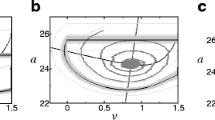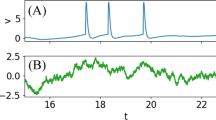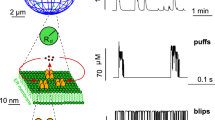Abstract
Long-range dependence (LRD) has been observed in a variety of phenomena in nature, and for several years also in the spiking activity of neurons. Often, this is interpreted as originating from a non-Markovian system. Here we show that a purely Markovian integrate-and-fire (IF) model, with a noisy slow adaptation term, can generate interspike intervals (ISIs) that appear as having LRD. However a proper analysis shows that this is not the case asymptotically. For comparison, we also consider a new model of individual IF neuron with fractional (non-Markovian) noise. The correlations of its spike trains are studied and proven to have LRD, unlike classical IF models. On the other hand, to correctly measure long-range dependence, it is usually necessary to know if the data are stationary. Thus, a methodology to evaluate stationarity of the ISIs is presented and applied to the various IF models. We explain that Markovian IF models may seem to have LRD because of non-stationarities.








Similar content being viewed by others
Notes
A limitation of the point process approach is that it is far from the biological reality.
References
Abry, P., Gonçalvès, P., Flandrin, P. (1995). Wavelets, spectrum analysis and 1/f processes, (pp. 15–29). New York: Springer.
Baddeley, R., Abbott, L.F., Booth, M.C., Sengpiel, F., Freeman, T., Wakeman, E.A., Rolls, E.T. (1997). Responses of neurons in primary and inferior temporal visual cortices to natural scenes, (Vol. 264 pp. 1775–1783).
Bair, W., Koch, C., Newsome, W., Britten, K. (1994). Power spectrum analysis of bursting cells in area mt in the behaving monkey. Journal of Neuroscience, 14(5), 2870–2892.
Beran, J., Feng, Y., Ghosh, S., Kulik, R. (2013). Long-memory processes. Heidelberg: Springer. Probabilistic properties and statistical methods.
Bhattacharya, R.N., Gupta, V.K., Waymire, E. (1983). The Hurst effect under trends. Journal of Applied Probability, 20(3), 649–662.
Bhattacharya, J., Edwards, J., Mamelak, A., Schuman, E. (2005). Long-range temporal correlations in the spontaneous spiking of neurons in the hippocampal-amygdala complex of humans. Neuroscience, 131(2), 547–555.
Brunel, N., & Sergi, S. (1998). Firing frequency of leaky intergrate-and-fire neurons with synaptic current dynamics. Journal of Theoretical Biology, 195(1), 87–95.
Cardinali, A., & Nason, G.P. (2010). Costationarity of locally stationary time series. Journal of Time Series Econometrics, 2(2), Article 1.
Cardinali, A., & Nason, G.P. (2018). Practical powerful wavelet packet tests for second-order stationarity. Applied and Computational Harmonic Analysis 44(3), 558–583.
Carmona, P., Coutin, L., Montseny, G. (2000). Approximation of some Gaussian processes. Statistical Inference for Stochastic Processes, 3(1-2), 161–171. 19th “Rencontres Franco-Belges de Statisticiens” (Marseille, 1998).
Chacron, M.J., Pakdaman, K., Longtin, A. (2003). Interspike interval correlations, memory, adaptation, and refractoriness in a leaky integrate-and-fire model with threshold fatigue. Neural Computation, 15(2), 253–278.
Churilla, A.M., Gottschalke, W.A., Liebovitch, L.S., Selector, L.Y., Todorov, A.T., Yeandle, S. (1995). Membrane potential fluctuations of human t-lymphocytes have fractal characteristics of fractional brownian motion. Annals of Biomedical Engineering, 24(1), 99–108.
Coeurjolly, J.-F. (2000). Simulation and identification of the fractional brownian motion: a bibliographical and comparative study. Journal of Statistical Software, 5(1), 1–53.
de Oliveira, R.C., Barbosa, C., Consoni, L., Rodrigues, A., Varanda, W., Nogueira, R. (2006). Long-term correlation in single calcium-activated potassium channel kinetics. Physica A: Statistical Mechanics and its Applications, 364, 13–22.
Decreusefond, L., & Nualart, D. (2008). Hitting times for Gaussian processes. The Annals of Probability, 36 (1), 319–330.
Delorme, M., & Wiese, K.J. (2015). Maximum of a fractional Brownian motion: analytic results from perturbation theory. Physical Review Letters, 115(21), 210601, 5.
Destexhe, A., Rudolph, M., Paré, D. (2003). The high-conductance state of neocortical neurons in vivo. Nature Reviews Neuroscience, 4(9), 739–751.
Doukhan, P. (1994). Mixing, properties and examples, volume 85 of lecture notes in statistics. New York: Springer.
Drew, P.J., & Abbott, L.F. (2006). Models and properties of power-law adaptation in neural systems. Journal of Neurophysiology, 96(2), 826–833.
Fairhall, A.L., Lewen, G.D., Bialek, W., de Ruyter van Steveninck, R.R. (2001). Efficiency and ambiguity in an adaptive neural code. Nature, 412, 787–792.
Gerstein, G.L., & Mandelbrot, B. (1964). Random walk models for the spike activity of a single neuron. Biophysical Journal, 4(1), 41–68.
Hammond, A., & Sheffield, S. (2013). Power law Pólya’s urn and fractional Brownian motion. Probability Theory and Related Fields, 157(3–4), 691–719.
Hodgkin, A.L., & Huxley, A.F. (1952). A quantitative description of membrane current and its application to conduction and excitation in nerve. The Journal of Physiology, 117(4), 500–544.
Jackson, B.S. (2004). Including long-range dependence in integrate-and-fire models of the high interspike-interval variability of cortical neurons. Neural Computation, 16(10), 2125–2195.
Kwiatkowski, D., Phillips, P.C., Schmidt, P., Shin, Y. (1992). Testing the null hypothesis of stationarity against the alternative of a unit root. Journal of Econometrics, 54(1), 159–178.
Lewis, C.D., Gebber, G.L., Larsen, P.D., Barman, S.M. (2001). Long-term correlations in the spike trains of medullary sympathetic neurons. Journal of Neurophysiology, 85(4), 1614–1622.
Lindner, B. (2004). Interspike interval statistics of neurons driven by colored noise. Physical Review E, 69, 022901.
Lowen, S.B., Cash, S.S., Poo, M.-m., Teich, M.C. (1997). Quantal neurotransmitter secretion rate exhibits fractal behavior. Journal of Neuroscience, 17(15), 5666–5677.
Lowen, S.B., Ozaki, T., Kaplan, E., Saleh, B.E., Teich, M.C. (2001). Fractal features of dark, maintained, and driven neural discharges in the cat visual system. Methods, 24(4), 377–394.
Lundstrom, B.N., Higgs, M.H., Spain, W.J., Fairhall, A.L. (2008). Fractional differentiation by neocortical pyramidal neurons. Nature Neuroscience, 11(11), 1335–1342.
Mandelbrot, B.B. (1965). Une classe de processus stochastiques homothétiques à soi; application à la loi climatologique de H. E. Hurst. C. R. Acad. Sci. Paris, 260, 3274–3277.
Mandelbrot, B.B. (1975). Limit theorems on the self-normalized range for weakly and strongly dependent processes. Z. Wahrscheinlichkeitstheorie und Verw. Gebiete, 31, 271–285.
Mandelbrot, B.B., & Wallis, J.R. (1968). Noah, Joseph, and operational hydrology. Water Resources Research, 4(5), 909–918.
Mandelbrot, B.B., & Van Ness, J.W. (1968). Fractional Brownian motions, fractional noises and applications. SIAM Review, 10(4), 422–437.
Metzler, R., & Klafter, J. (2004). The restaurant at the end of the random walk: recent developments in the description of anomalous transport by fractional dynamics. Journal of Physics. A. Mathematical and General, 37 (31), R161–R208.
Middleton, J.W., Chacron, M.J., Lindner, B., Longtin, A. (2003). Firing statistics of a neuron model driven by long-range correlated noise. Physical Review E, 68, 021920.
Nason, G. (2013). A test for second-order stationarity and approximate confidence intervals for localized autocovariances for locally stationary time series. Journal of the Royal Statistical Society. Series B. Statistical Methodology, 75(5), 879–904.
Peng, C.K., Buldyrev, S.V., Goldberger, A.L., Havlin, S., Sciortino, F., Simon, M., Stanley, H.E. (1992). Long-range correlations in nucleotide sequences. Nature, 356, 168–170.
Peng, C.-K., Mietus, J., Hausdorff, J.M., Havlin, S., Stanley, H.E., Goldberger, A.L. (1993). Long-range anticorrelations and non-Gaussian behavior of the heartbeat. Physical Review Letters, 70, 1343–1346.
Peng, C.-K., Buldyrev, S.V., Havlin, S., Simons, M., Stanley, H.E., Goldberger, A.L. (1994). Mosaic organization of DNA nucleotides. Physical Review E, 49, 1685–1689.
Pozzorini, C., Naud, R., Mensi, S., Gerstner, W. (2013). Temporal whitening by power-law adaptation in neocortical neurons. Nature neuroscience, 16(7), 942–948.
Priestley, M.B., & Subba Rao, T. (1969). A test for non-stationarity of time-series. Journal of the Royal Statistical Society. Series B. Methodological, 31, 140–149.
Rangarajan, G., & Ding, M. (Eds.). (2003). Processes with long-range correlations: theory and applications, volume 621 of Lecture Notes in Physics. Berlin: Springer.
Richard, A., & Talay, D. (2016). Hölder continuity in the Hurst parameter of functionals of Stochastic Differential Equations driven by fractional Brownian motion. arXiv:1605.03475.
Sacerdote, L., & Giraudo, M.T. (2013). Stochastic integrate and fire models: a review on mathematical methods and their applications. In Stochastic biomathematical models, volume 2058 of Lecture Notes in Math. (pp. 99–148). Heidelberg: Springer.
Samorodnitsky, G. (2016). Stochastic processes and long range dependence. Springer Series in Operations Research and Financial Engineering. Cham: Springer.
Schwalger, T., & Schimansky-Geier, L. (2008). Interspike interval statistics of a leaky integrate-and-fire neuron driven by Gaussian noise with large correlation times. Physical Review E, 77, 031914.
Schwalger, T., Fisch, K., Benda, J., Lindner, B. (2010). How noisy adaptation of neurons shapes interspike interval histograms and correlations. PLoS Computational Biology, 6(12), e1001026, 25.
Schwalger, T., Droste, F., Lindner, B. (2015). Statistical structure of neural spiking under non-Poissonian or other non-white stimulation. Journal of Computational Neuroscience, 39(1), 29–51.
Segev, R., Benveniste, M., Hulata, E., Cohen, N., Palevski, A., Kapon, E., Shapira, Y., Ben-Jacob, E. (2002). Long term behavior of lithographically prepared in vitro neuronal networks. Physical Review Letters, 88, 118102.
Sobie, C., Babul, A., de Sousa, R. (2011). Neuron dynamics in the presence of 1/f noise. Physical Review E, 83, 051912.
Sottinen, T. (2001). Fractional Brownian motion, random walks and binary market models. Finance and Stochastics, 5(3), 343–355.
Taqqu, M.S. (1975). Weak convergence to fractional Brownian motion and to the Rosenblatt process. Z. Wahrscheinlichkeitstheorie und Verw. Gebiete, 31, 287–302.
Taqqu, M.S., Teverovsky, V., Willinger, W. (1995). Estimators for long-range dependence: an empirical study. Fractals, 03(04), 785–798.
Teich, M.C. (1992). Fractal neuronal firing patterns. In McKenna, T., Davis, J., Zornetzer, S. F. (Eds.), Single Neuron Computation, Neural Networks: Foundations to Applications (pp. 589–625). San Diego: Academic Press.
Teich, M.C., Turcott, R.G., Siegel, R.M. (1996). Temporal correlation in cat striate-cortex neural spike trains. IEEE Engineering in Medicine and Biology Magazine, 15(5), 79–87.
Teich, M.C., Heneghan, C., Lowen, S.B., Ozaki, T., Kaplan, E. (1997). Fractal character of the neural spike train in the visual system of the cat. Journal of the Optical Society of America A, 14(3), 529–546.
Teka, W., Marinov, T.M., Santamaria, F. (2014). Neuronal spike timing adaptation described with a fractional leaky integrate-and-fire model. PLoS Computational Biology, 10(3), e1003526.
Weron, R. (2002). Estimating long-range dependence: finite sample properties and confidence intervals. Physica A. Statistical Mechanics and its Applications, 312(1-2), 285–299.
Willinger, W., Taqqu, M.S., Sherman, R., Wilson, D.V. (1997). Self-similarity through high-variability: statistical analysis of ethernet lan traffic at the source level. IEEE/ACM Transactions on Networking, 5(1), 71–86.
Zilany, M.S., Bruce, I.C., Nelson, P.C., Carney, L.H. (2009). A phenomenological model of the synapse between the inner hair cell and auditory nerve: long-term adaptation with power-law dynamics. The Journal of the Acoustical Society of America, 126(5), 390–2412.
Acknowledgements
Part of this work was carried out while A.R. was a postdoc at Inria Sophia-Antipolis and at Ecole Polytechnique (the support from ERC 321111 Rofirm is gratefully acknowledged). A.R. and E.T. acknowledge the support from the ECOS-Sud Program Chili-France C15E05 and from the European Union’s Horizon 2020 Framework Program for Research and Innovation under Grant Agreement No. 720270 (Human Brain Project SGA1). P.O acknowledges the support from the Advanced Center for Electrical and Electronic Engineering (Basal Funding FB0008, Conicyt) and the project P09-022-F from the Millennium Scientific Initiative of the Chilean Ministry of Economy, Development, and Tourism.
We thank the reviewers for their remarks which helped to improve significantly the quality of this paper.
Author information
Authors and Affiliations
Corresponding author
Ethics declarations
Conflict of Interest
The authors declare that they have no conflict of interest.
Additional information
Action Editor: A. Compte
Rights and permissions
About this article
Cite this article
Richard, A., Orio, P. & Tanré, E. An integrate-and-fire model to generate spike trains with long-range dependence. J Comput Neurosci 44, 297–312 (2018). https://doi.org/10.1007/s10827-018-0680-1
Received:
Revised:
Accepted:
Published:
Issue Date:
DOI: https://doi.org/10.1007/s10827-018-0680-1




